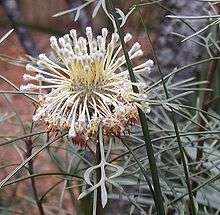Isopogon dawsonii
| Isopogon dawsonii | |
|---|---|
 | |
| Scientific classification | |
| Kingdom: | Plantae |
| (unranked): | Angiosperms |
| (unranked): | Eudicots |
| Order: | Proteales |
| Family: | Proteaceae |
| Genus: | Isopogon |
| Species: | I. dawsonii |
| Binomial name | |
| Isopogon dawsonii F.Muell. ex R.T.Baker | |
Isopogon dawsonii, commonly known as the Nepean cone bush is a shrub of the family Proteaceae that is endemic to the ranges west of Sydney in New South Wales, Australia.
In occurs naturally on sandstone in heathland and dry sclerophyll forest.

Description
Isopogon dawsonii grows as an upright shrub, its height usually ranging between 1 and 3 metres,[1] though there have been anecdotal reports of up to 6 m (20 ft).[2] The leaves are narrow and divided and are 8 to 12 cm long. They are hoary at first, becoming glabrescent later, and are carried on reddish-brown branchlets. It has greyish-cream sessile (stalkless) flowers that appear in late winter to spring. Rounded "drumsticks" containing the seeds appear later, formed from the old flower parts.
Cultivation
Seldom cultivated, Isopogon dawsonii is fairly easy to grow on a neutral to acidic sandy soil or sandy loam with plenty of sun or dappled shade. It is being considered as a grafting stock for Western Australian members of Isopogon.
It can be seen in public gardens such as the Australian Botanic Garden Mount Annan near Sydney, Glenbrook Native Plant Reserve in the Blue Mountains and the Royal Botanic Gardens in Melbourne.
References
- ↑ P.H. Weston. "New South Wales Flora Online: Isopogon dawsonii". Royal Botanic Gardens & Domain Trust, Sydney, Australia.
- ↑ "Isopogon dawsoni R.T.Baker". Flora of Australia Online. Department of the Environment and Heritage, Australian Government.